Common Treatments
Crowding of the teeth
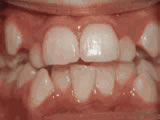
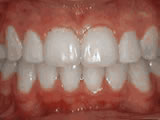
Patient started treatment at age 11 and wore braces for 26 months. He loves his new smile.
Crowding is the lack of space for all the teeth to fit normally within the jaws. The teeth may be twisted or displaced. Crowding occurs when there is a disharmony in the tooth to jaw size relationship or when the teeth are larger than the available space. Crowding can be caused by improper eruption of teeth and early or late loss of primary teeth.
Crowding should be corrected because it can:
- Prevent proper cleaning of all the surfaces of your teeth
- Cause dental decay Increase the chances of gum disease
- Prevent proper functioning of teeth
- Make your smile less attractive
How can crowding be orthodontically corrected?
Extra space can be created by expansion of the arches, extraction of teeth, or reducing the size of some existing teeth. Once space is created, braces will eliminate crowding and align the teeth. Correction of crowding can help prevent dental decay and periodontal disease by improving the ability to remove plaque from the teeth.
Open bite: Front teeth don't touch
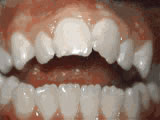
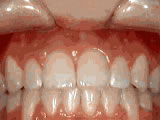
Patient sucked her thumb as a young child. She started treatment at age 13. She had braces and a special appliance — called a crib — to retrain the tongue, for 28 months. Now she can bite the lettuce out of a sandwich.
An openbite is an insufficient vertical overlap of the teeth. It is caused by oral habits such as tongue-thrust, thumb/finger-sucking or when the jaws are growing apart. Timing of treatment and elimination of any habits is critical to the overall success of the therapy.
How can an openbite be orthodontically corrected?
An openbite can be corrected through growth modification of the jaws using orthopedic appliances and braces, extrusion of the front teeth, intrusion of the back teeth, and in some cases surgical correction of the jaws. Additionally, breaking oral habits, such as tongue-thrusting or thumb-sucking, will facilitate the correction of an openbite.
Deep overbite: Lower front teeth bite into palate
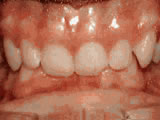
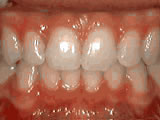
This adult patient, age 25, required braces and jaw surgery to correct his severe overbite, with treatment taking two years. His problem could have been corrected without surgery if he had been treated before he was a teenager.
An overbite is an excessive amount of overlap of the upper front teeth over the lower front teeth. Generally there is no contact between the upper and lower front teeth and often you cannot see the lower incisors. An overbite can be caused by a disproportionate amount of eruption of front teeth or a front to back discrepancy in the growth of the upper and lower jaw. Overbite is also known as a deep bite.
Overbite should be corrected because it can:
- Cause improper functioning of your front teeth
- Result in the lower front teeth biting into the gum tissue of the upper palate leading to tissue problems
- Unusual wear of the lower front teeth
- Cause jaw or joint problems
- Make your smile less attractive
How can an overbite be orthodontically corrected?
An overbite can be corrected by moving the upper front teeth up, the lower front teeth down, and/or erupting the back teeth together, which will open the bite so the teeth are properly aligned and the deep bite is eliminated.
Missing Teeth
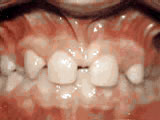
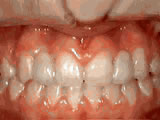
This patient's lateral incisors were congenitally missing. She had braces for 20 months to move the teeth into their correct positions, then the missing teeth were replaced with bonded "Maryland" bridges.
Missing teeth is the absence of a tooth or teeth that should normally be present. This can be caused by trauma or lack of development.
This problem should be corrected because it can:
- cause improper functioning of teeth
- cause premature wear of teeth
- cause asymmetric and improper alignment of the teeth
- make your smile less attractive
How can missing teeth be orthodontically corrected?
Depending on the situation, the space can be closed with braces or opened for tooth replacement. If a space is created, a bridge or dental implant are restorative options for replacement of the missing tooth. We will work in cooperation with your restorative dentist to determine the appropriate treatment plan for your individual case.
Underbite: Lower front teeth in front of upper teeth.
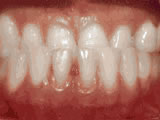
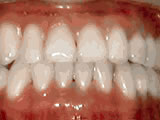
Patient's underbite was causing her jaw joint discomfort and excessive wear patterns on her teeth. After about 30 months of treatment starting at age 32, she now finds smiling and chewing much easier.
An underbite is when the lower teeth protrude past the front teeth. An underbite is usually caused by undergrowth of the upper jaw, overgrowth of the lower jaw, or a combination of the two (Class III Relationship). An underbite can also be caused by flared lower incisors, missing upper teeth or a combination of all the above. Early correction of an underbite is recommended.
An underbite should be corrected because it can:
- Prevent proper functioning of the front teeth or molars which can lead to premature wear of the teeth
- Cause chewing or eating problems
- Cause jaw or joint problems
- Make your smile less attractive
How can an underbite be orthodontically corrected?
An underbite can be corrected through growth modification of the jaws, extraction of teeth and in some cases, surgical correction of the jaws.
Spacing of teeth
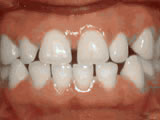
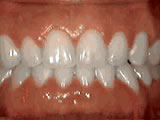
Patient was bothered by the spaces between his teeth. Braces closed the spaces and gave him an ideal bite in 24 months. Special glued-in retainers help keep the spaces closed.
Spacing is an excess of space between your teeth. This generally occurs when the teeth are smaller than the available space. Spacing can also be caused by protrusive teeth, missing teeth, impacted teeth or abnormal tissue attachments to the gums.
Spacing should be corrected because it can:
- Result in gum problems due to the lack of protection by the teeth
- prevent proper functioning of the teeth
- make your smile less attractive
How can spacing of the teeth be orthodontically corrected?
The spaces can be closed by moving the teeth together and properly aligning them within the arch. In the case of a tooth size discrepancy (Bolton discrepancy) the congenitally small teeth may need to have a cosmetic restoration after orthodontic treatment is completed to restore the tooth to its proper size.
Overjet: Protruding front teeth
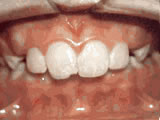
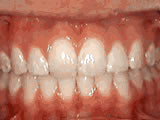
At age ten, patient had a big overjet with the top teeth protruding beyond the bottom. She had two phases of treatment. The first helped her jaws to grow more harmoniously and the second aligned her teeth and bite. At age 13, she was proudly displaying her new smile.
An overjet is an excessive protrusion of the upper front teeth or when the lower teeth are too far behind the upper front teeth. This can be caused by an improper alignment of the molars (Class II Relationship), a skeletal imbalance of the upper and lower jaw, flared upper incisors, missing lower teeth or a combination of all the above. In addition, oral habits such as thumb sucking, finger sucking, or tongue thrusting can exacerbate the condition.
Overjet should be corrected because it can:
- Prevent proper functioning of the front teeth
- Lead to premature wear
- Make your smile less attractive
How can overjet be orthodontically corrected?
An overjet can be corrected through growth modification using a functional appliance and/or elastics to reduce the skeletal imbalance or extraction of teeth. In some cases surgical correction of the jaws will be necessary.
Non-braces treatment
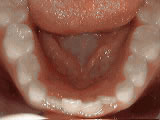
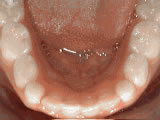
This patient was first seen at age seven for crowding of the lower permanent teeth. A procedure was performed to reduce the width of the adjacent baby teeth and the permanent incisors aligned on their own in nine months.
Sometimes braces are not needed to get noticeable improvements in tooth alignment. This patient was first seen at age seven for crowding of the lower permanent teeth. A procedure was performed to reduce the width of the adjacent baby teeth and the permanent incisors aligned on their own in nine months.
Phase-One: Crossbite Correction
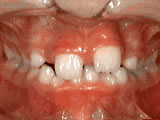
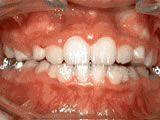 Patient's parents were concerned about both aesthetics and the health of the erupting permanent teeth when they brought him to the orthodontist at age eight. The lower front teeth were crowded and touching the palate, and the upper front teeth were extremely displaced from their normal positions. After 12 months of Phase-One treatment with an expander and partial braces, patient's appearance and dental function was vastly improved.
Patient's parents were concerned about both aesthetics and the health of the erupting permanent teeth when they brought him to the orthodontist at age eight. The lower front teeth were crowded and touching the palate, and the upper front teeth were extremely displaced from their normal positions. After 12 months of Phase-One treatment with an expander and partial braces, patient's appearance and dental function was vastly improved.A crossbite is when one or more upper teeth bite on the inside of the lower teeth. It can occur in the front and/or the sides of the mouth and with a single tooth or multiple teeth. Early correction of a crossbite is recommended.
Crossbites should be corrected because they can:
- Prevent proper functioning of the front teeth
- Lead to premature wear
- Make your smile less attractive
- Cause premature wear of the teeth
- Cause gum disease including bone loss
- Cause asymmetrical development of the jaws
- Cause dysfunctional chewing patterns
- Make your smile less attractive
How can a crossbite be orthodontically corrected?
If there is a single tooth crossbite, the tooth can be moved with braces into the correct position. In some cases, a retainer can be utilized. When multiple teeth are in crossbite, the arch needs to be expanded with braces or other intra-oral appliance such as a palatal expander.
Impacted Teeth
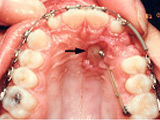
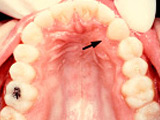
This patient had an impacted canine that was brought into the mouth orthodontically and then patient had cosmetic bonding completed to enlarge the congenitally small maxillary lateral incisors.
An impaction is when a tooth cannot erupt on its own due to a poor position. It can be caused by improper positioning of the developing tooth bud, early loss of primary teeth or crowding. This can cause the tooth to fail to erupt into the mouth. “Wisdom teeth” (third molars) are the most commonly impacted teeth. Canines and premolars can also be impacted.
This problem should be corrected because it can:
- cause damage to the root structure of adjacent teeth
- interfere with the sinus cavity
- leave unwanted spaces
- lead to improper functioning of the teeth
- cause premature wear of the teeth
- case asymmetric alignment of the teeth
How can impacted teeth be orthodontically corrected?
Usually the impacted tooth is surgically exposed by an oral surgeon and brought into the correct position over several months. This allows us to then guide eruption of the impacted tooth into the proper position. In some cases, the jaws are too small to accommodate all the developing permanent teeth. In these cases, early treatment can help prevent impactions.


